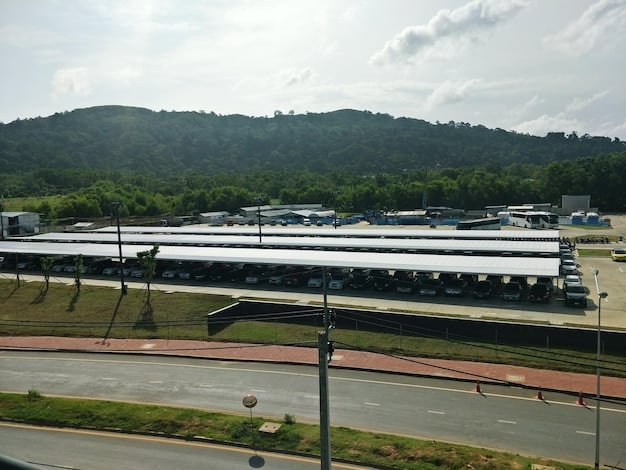Latest Battery Storage Tech: Impact on the US Energy Market

The latest technological advancements in battery storage, including solid-state batteries, flow batteries, and advanced lithium-ion technologies, promise to revolutionize the US energy market by enhancing grid stability, improving renewable energy integration, and reducing reliance on fossil fuels.
The energy landscape in the United States is undergoing a dramatic shift, driven by the urgent need for sustainable and reliable power solutions. What Are the Latest Technological Advancements in Battery Storage and How Will They Affect the US Energy Market? This question is at the forefront as innovations in battery technology promise to reshape how we generate, store, and utilize energy.
The Evolution of Battery Storage Technology
Battery storage technology has evolved significantly over the past decade, moving from simple lead-acid batteries to sophisticated lithium-ion and beyond. These advancements are crucial for addressing the intermittency of renewable energy sources like solar and wind.
Understanding the trajectory of battery storage helps to appreciate the potential impact on the US energy market.
Early Battery Technologies
The groundwork was laid by older technologies. Improvements in these areas provided a baseline.
- Lead-acid batteries: Used for over a century, they’re still viable for specific applications.
- Nickel-cadmium batteries: Offered better energy density than lead-acid but faced environmental concerns.
- Flow batteries: An early technology that allowed for independent scaling of power and energy capacity.
The Rise of Lithium-Ion
Lithium-ion batteries transformed portable electronics. Their adoption in energy storage scaled up as demand increased.
- High energy density: Lithium-ion has packed more energy into smaller, lighter packages.
- Decreasing costs: Manufacturing improvements have led to significant cost reductions.
- Versatile applications: Suitable for residential, commercial, and grid-scale storage.
Today, lithium-ion is the dominant technology, and ongoing refinement continues to push performance boundaries forward.

Recent Breakthroughs in Battery Technology
Several emerging technologies are poised to leapfrog current lithium-ion systems. These innovations aim to address limitations such as energy density, safety, and lifespan.
The following breakthroughs are set to shape the future of energy storage.
Solid-State Batteries
Solid-state batteries replace the liquid electrolyte with a solid one. They promise higher energy density and improved safety.
- Increased energy density: Solid electrolytes enable the use of higher voltage electrodes.
- Enhanced safety: Eliminating flammable liquid electrolytes reduces fire risk.
- Longer lifespan: Solid electrolytes are more stable, leading to extended cycle life.
Flow Batteries
Flow batteries store energy in liquid electrolytes that are pumped through a cell stack. They offer independent scaling of power and energy capacity.
- Scalability: Energy capacity can be increased by simply adding more electrolyte.
- Long lifespan: Flow batteries can last for tens of thousands of cycles.
- Non-flammable: Safe and suitable for urban environments.
Advanced Lithium-Ion Technologies
Ongoing research is improving lithium-ion batteries through innovations in electrode materials, electrolytes, and cell design.
- Silicon anodes: Increase energy density by replacing graphite with silicon.
- Lithium-sulfur batteries: Promise very high energy density but face challenges with cycle life.
- Advanced electrolytes: Improve safety, performance, and lifespan.
Impact on Renewable Energy Integration
Battery storage is vital for integrating intermittent renewable energy sources into the grid. Without storage, it’s challenging to ensure a consistent power supply from solar and wind.
The impact of battery storage on renewable energy expansion is considerable.
Smoothing Renewable Energy Output
Batteries smooth out the peaks and valleys of renewable energy generation.
- Storing excess energy: Batteries capture excess energy during periods of high production.
- Releasing energy when needed: Batteries discharge energy when renewable sources are unavailable.
- Matching supply with demand: Helps align energy supply more closely with consumer demand.
Enabling Grid Stability
Battery storage enhances grid stability by providing quick response to fluctuations in frequency and voltage.
The integration of renewable energy increases the need of grid-scale energy storage.
* Voltage Support: Batteries provide reactive power to stabilize voltage levels.
* Frequency Regulation: Quick response of batteries maintains grid frequency.
* Reduced Congestion: Storing energy locally alleviates transmission congestion.
Encouraging Renewable Energy Investments
Reliable energy storage makes renewable energy projects more attractive to investors.
- Guaranteeing power supply: Storage ensures renewables can meet contracted delivery obligations.
- Reducing curtailment: Storage reduces the waste of excess renewable energy production.
- Increasing project value: Storage adds value to renewable energy projects.
Economic Implications for the US Energy Market
The deployment of advanced battery storage has significant economic implications. These include creating new industries, reducing energy costs, and enhancing energy security.
Here are some of the key economic considerations.
Job Creation
The battery storage industry is creating new jobs in manufacturing, installation, and maintenance.
- Manufacturing jobs: Building battery cells, modules, and systems.
- Installation jobs: Deploying batteries at residential, commercial, and grid-scale.
- Maintenance jobs: Servicing and maintaining battery storage systems.
Reducing Energy Costs
Battery storage can lower energy costs by reducing peak demand charges and enabling more efficient use of renewable energy.
- Peak shaving: Batteries reduce demand during peak hours, avoiding high prices.
- Arbitrage: Buying energy when it’s cheap and selling it when it’s expensive.
- Optimized grid operations: Reduced infrastructure investment due to storage deployment.
Enhancing Energy Security
Reducing reliance on fossil fuels and improving grid resilience enhances energy security.
- Reducing imports: Battery storage lowers the need for imported fuels.
- Strengthening grid resilience: Local storage withstands grid outages and disruptions.
- Diversifying energy sources: Battery storage encourages a diverse energy supply.

Policy and Regulatory Landscape
Government policies and regulations play a crucial role in fostering the growth of the battery storage market. Incentives, mandates, and standards can all accelerate deployment.
The impacts of policy frameworks on battery storage adoption are immense.
Federal Initiatives
Federal initiatives provide funding and incentives for battery storage projects.
- Investment tax credits: Incentivize the deployment of energy storage technologies.
- Grants and loans: Support research, development, and demonstration projects.
- Energy storage targets: Set goals for battery storage deployment.
State-Level Policies
States are implementing their own policies to promote energy storage.
- Storage mandates: Requiring utilities to procure a certain amount of energy storage.
- Incentive programs: Offering rebates and tax credits for battery storage.
- Interconnection standards: Streamlining the process of connecting batteries to the grid.
Regulatory Reforms
Regulatory reforms are needed to enable fair compensation for the services that storage provides to the grid.
- Valuing grid services: Compensation for frequency regulation, voltage support, and capacity.
- Market participation: Allowing storage to participate in energy and ancillary services markets.
- Streamlined permitting: Reducing bureaucratic hurdles.
Challenges and Opportunities
While the future of the US energy market looks promising, several challenges and opportunities lie ahead. Addressing these will be critical to realizing the full potential of battery storage.
Let’s examine the factors influencing the growth of battery storage.
Cost Reduction
Continue to drive down the cost of battery storage to increase its competitiveness with other energy technologies.
Lower cost enables more investment and faster growth.
Technological Advancements
Support research and development to further improve energy density, safety, and lifespan.
Improved technologies are key to expanding the range of applications.
Supply Chain Security
Ensure a secure and reliable supply chain for battery materials.
Securing the supply chain mitigates risk.
Workforce development
It is important to create programs for training people.
Investment in education programs will improve economic outlook.
Summary Table
| Key Point | Brief Description |
|---|---|
| ⚡ Solid-State Batteries | Improved safety and higher energy density by using solid electrolytes. |
| 🔋 Flow Batteries | Scalable energy storage with independent power and energy capacity. |
| ☀️ Renewable Integration | Enables smoothing of renewable energy output and grid stabilization. |
| 💰 Economic Benefits | Job creation, reduced energy costs, and enhanced energy security. |
Frequently Asked Questions
▼
Solid-state batteries replace the liquid electrolyte found in lithium-ion batteries with a solid electrolyte. This change enhances safety, increases energy density, and extends the lifespan of the battery.
▼
Flow batteries store energy in liquid electrolytes, pumping it through a cell stack for charging and discharging. They allow for scalable energy storage with independent control of power and energy capacity, ideal for grid-scale applications.
▼
Battery storage smooths the intermittent output of renewables by storing excess energy during high production and releasing it when needed. This ensures a stable and reliable energy supply, enhancing grid stability.
▼
Advanced battery storage creates jobs in manufacturing, installation, and maintenance, reduces peak demand charges, and enhances energy security by reducing reliance on fossil fuels and strengthening grid resilience.
▼
Supportive policies include investment tax credits, state-level mandates for energy storage, and regulatory reforms that fairly value the services storage provides to the grid, such as frequency regulation and voltage support.
Conclusion
The latest technological advancements in battery storage are poised to transform the US energy market by enabling greater integration of renewable energy, enhancing grid stability, and creating new economic opportunities. Overcoming challenges related to cost, technology, and policy will be critical to realizing the full potential of this transformative technology.





